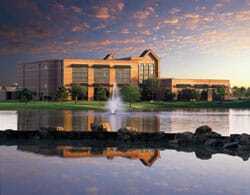Residential master-planned communities have traditionally performed better than general subdivisions in terms of sales volume and value appreciation. That trend may have accelerated during last year’s turbulent market conditions as some top-selling communities repositioned their product choices and marketing strategies to succeed in the worst year for new-home sales in a half century.
The U.S. Department of Commerce reported that total 2010 new-home sales across the country sank to their lowest level—323,000—since at least 1963, as the popular first-time homebuyer tax credit expired for good. Yet 2010 sales at top-selling master-planned communities turned around and climbed above 2008 and 2009 levels, according to annual surveys compiled by RCLCO, a real estate consulting firm based in the Washington, D.C., metropolitan area.
Among the master-planned communities that saw increased new-home sales in 2010 were the Woodlands and Sienna Plantation in the Houston metropolitan area; Mountain’s Edge in Las Vegas; and the Villages of Irvine (the Irvine Ranch) outside Los Angeles. In the Houston and Las Vegas metro areas, sales in master-planned communities have grown from 15 percent of the new-home market before the economic recession to 25 percent today, according to developers in those markets.
“It’s very challenging to sell homes anywhere today, but master-planned communities are definitely selling better than non-master-planned subdivisions,” says Mollie Carmichael, a principal with John Burns Real Estate Consulting, based in Los Angeles, and a member of ULI’s Community Development Council (Silver Flight). “They’re more popular because they’re giving the consumer more lifestyle for the price today.”
Indeed, master-planned communities are large-scale developments often encompassing thousands of acres and tens of thousands of residents. They offer a variety of housing choices and the amenities of a small city, such as commercial strips, office developments, schools, parks, and even community events, all controlled by a master developer. The communities are self-contained and well-maintained villages with a branded image, which helps hold value and attract buyers.
In fact, market research conducted by the John Burns firm has determined that residences in master-planned communities command a 5 to 10 percent price premium over comparable homes outside such communities, and another recent RCLCO study in California, Florida, and Texas found the pace of home sales was 50 percent higher in communities with multiple amenities than in subdivisions that lacked them. Overall, according to several real estate experts, new-home buyers during the housing downturn exhibited what’s been termed a “flight to quality,” or a movement to safer, more stable housing investments.
| The Sienna Springs Resort pool is the newest water attraction at Sienna Plantation, located in the Houston area. It has a tower at the center and two children’s water slides. |
| The Cinco Ranch Branch Library opened in 2004 with the help of a community fundraising campaign. |
“Buyers were more wary than ever about buying into a distressed community and getting burned,” says Gregg Logan, managing director of RCLCO’s Community Development Practice Group.
Top-selling master-planned communities had the advantage of being fairly well capitalized, enabling their developers to continue investing in the communities even as the economy stalled. In interviews about RCLCO’s top ten–selling communities of 2010, four common strategies and themes stood out about their successes:
- Most communities adjusted and repositioned their housing choices to meet the demands of the changing consumer market.
- Most communities also altered their advertising and marketing tactics.
- Some communities effectively pursue specific growing demographic niches.
- Finally, being in the healthy Houston metropolitan area was an added bonus.
During the housing boom of the mid-2000s, many master-planned communities had mirrored the rest of the housing industry, focusing on building upper-end homes. But once the recession hit, some communities worked diligently to adapt quickly.
Sienna Plantation, for example, began offering smaller lots with slightly lower price points, targeting not the first-time buyer but the first-time move-up buyer, says Doug Goff, chief operating officer of Johnson Development Corp. At Brambleton, located outside Washington, D.C., in Loudoun County, Virginia, developer Soave Enterprises challenged builders to create new architectural styles that could catch buyers’ attention in a competitive marketplace. They responded with, among other things, brownstone townhouses that included big windows and small outdoor porch nooks, says Bill Fox, Soave’s chief operating office of Brambleton.
But perhaps no master-planned community developer put as much effort into creating new products as the Irvine Company, whose Irvine Ranch already encompasses nearly 100,000 acres (40,500 ha) and 300,000 residents. “We started with the premise that more of the same wouldn’t work,” says Daniel Young, the Irvine Company’s president of community development.
The company conducted some unusual research. It gave a couple hundred potential homebuyers $250 gift cards to visit model homes outside the community and rate what they liked or did not like about every room in the house. The company also filmed another 100 families talking about what they liked and did not like about their own homes. All this resulted in a realization that the current floor plans were not working for new buyers.
So in early 2010, Irvine introduced its 2010 New Home Collection with eight models of new homes that included such features as the following: “great rooms” combining the kitchen, living room, and dining room; a roof-covered patio called a “California room”; and a “mud room” space by a door where kids (and adults) can shed dirty clothes and shoes before entering the rest of the house. “We created a new home for a new generation,” Young says. The company signed up more than 1,000 buyers of these new-style homes last year, doubling its goal.
Before the economic downturn, master-planned communities typically used traditional media—newspaper ads and radio spots—to market their brand. But as developers cut back on advertising budgets, they made their marketing more targeted and creative to lure prospective buyers.
Newland Communities, which had two Houston-area developments—Cinco Ranch and Telfair—on RCLCO’s top-ten list, began buying inexpensive ads on real estate websites and school-search websites such as greatschools.net. Elsewhere, communities launched YouTube videos to tell their stories and also stepped up event-driven marketing, holding community social and charity events ranging from festivals to garden club tours—all open to the public—as ways to attract attention and possible future buyers.
In Las Vegas, Focus Property Group’s Providence holds a fall entertainment and crafts festival called Red Apple Days that complements the development’s old-fashioned, small-town America theme. Builders are also on hand offering promotional incentives for prospective buyers. “We find experiential marketing is the most effective marketing,” says John Ritter, Focus Property’s chief executive. “Selling a community these days is very much like how a car is marketed—it’s not so much about the product but how it makes you feel.”
Many master-planned communities offer enough housing styles to have something for everyone, from singles to young families and up through empty nesters. But some successful communities have taken a more customized approach, narrowing the focus to select demographic groups.
The Villages, whose 2,100 sales in 2010 made it the number-one-selling community in RCLCO’s rankings, is a giant age-restricted community outside Orlando that caters just to retirees. That is a popular target market for master-planned developments, but certainly not the only one. In Houston, for instance, Newland Communities’ Telfair pursued the Asian and Indian ethnic segments with homes that could serve multigenerational households, with features ranging from second kitchens to prayer rooms. And in Denver, Stapleton was developed in a new urbanist style, with streets in a grid, homes with front porches, and schools within walking distance, to appeal to urban dwellers.
“We provide the only large-scale opportunity for young Denver residents to buy a new home to maintain an urban lifestyle. Otherwise, they have to go to the suburbs,” says Jim Chrisman, senior vice president for the Forest City Stapleton development company.
RCLCO’s annual rankings used to be dominated by western metropolitan areas. In 2005, for example, Las Vegas had four of the top ten, while Phoenix had five of the top 13. Since 2007, however, Houston has been the dominant metro area for master-planned sales, with four and sometimes five communities ranked in the top ten every year.
According to developers there, the Houston market was not overbuilt during the housing boom, so the new-home market did not dry up, as happened in other fast-growing metropolitan areas. Meanwhile, the oil and gas industry continued to expand and create new jobs, bringing in out-of-towners.
“We’ve gotten the jobs, and they sell houses,” says Tim Welbes, copresident of the Woodlands Development Co., which oversees the Woodlands, a commercial-centered community north of Houston that contains more jobs than households.
Going forward in the housing market, RCLCO’s consumer surveys indicate that a growing share of prospective homebuyers is seeking smaller but more functional residences with more livable outdoor space as well as greater connectivity to jobs, schools, shopping, and recreation. That bodes well for master-planned communities, especially those with progressive management. As RCLCO concluded in its report on the best-selling communities: “The most successful MPCs will continue to be those that are constantly adapting to the changing real estate environment.”






